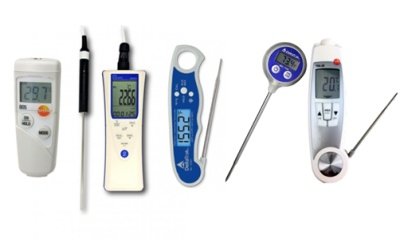Food thermometers aren’t just for your holiday roasts—they’re for all cuts and sizes of meat and poultry, including hamburgers, chicken breasts and pork chops. Using a food thermometer when cooking meat, poultry, and even egg dishes is the only reliable way to make sure you are preparing a safe meal, and also helps to retain flavor and to avoid overcooking foods.
Thermometers
|
TYPES
|
SPEED
|
PLACEMENT
|
|
Bimetal (instant read)
|
15-20 seconds
|
2-2 1/2 inches deep in the thickest part of the food.
|
|
Thermistor (digital)
|
10 seconds
|
At least 1/2 inch deep in a food
|
|
Thermocouple (digital)
|
5 seconds
|
1/2 inch deep or deeper, as needed
|

Why Use a Food Thermometer
Everyone is at risk for foodborne illness. The Centers for Disease Control and Prevention (CDC) estimate that every year about 48 million people in the United States become ill from harmful bacteria in food, and, of these, about 3,000 die. Some people may be at high risk for developing a foodborne illness. These include pregnant women and their unborn babies, newborns, young children, older adults, people with weakened immune systems, and individuals with certain chronic illnesses. These people should pay extra attention to handling food safely.
Types of Food Thermometers
Choose and use the one that is right for you! The dial oven-safe thermometer is commonly used for roasting turkey and other large meats. The digital instant-read thermometer is easy to use for those foods that you will remove from the oven, microwave or grill to quickly check the internal temperature.
Dial Oven-Safe (Bimetal)
Reads in 1-2 minutes
Place 2-2½” deep in thickest part of food
Can be used in roasts, casseroles, and soups
Not appropriate for thin foods
Can remain in food while it’s cooking
Heat conduction of metal stem can cause false high reading
Some models can be calibrated; check manufacturer’s instructions
Digital Instant-Read (Thermistor)
Reads in 10 seconds
Place at least ½” deep
Can measure temperature in thin and thick foods
Not designed to remain in food while it’s cooking
Check internal temperature of food near the end of cooking time
Some models can be calibrated; check manufacturer’s instructions
Available in “kitchen” stores
Fork
Reads in 2-10 seconds
Place at least ¼” deep in thickest part of food
Can be used in most foods
Not designed to remain in food while it is cooking
Sensor in tine of fork must be fully inserted
Check internal temperature of food near end of cooking time
Dial Instant-Read
Reads in 15-20 seconds
Place 2-2½” deep in thickest part of food
Can be used in roasts, casseroles, and soups
Temperature is averaged along probe, from tip to 2-3″ up the stem
Cannot measure thin foods unless inserted sideways
Not designed to remain in food while it is cooking
Use to check the internal temperature of a food at the end of cooking time
Some models can be calibrated; check manufacturer’s instructions
Readily available in stores
Thermocouple
Reads in 2-5 seconds
Place ¼” or deeper, as needed
Good for measuring temperatures of thick and thin foods
Not designed to remain in food while it’s cooking
Check internal temperature of food near the end of cooking time
More costly; may be difficult for consumers to find in stores
Disposable Temperature Indicators (Single-use)
Reads in 5-10 seconds
Place approximately ½” deep (follow manufacturer’s directions)
Not designed to be left in food while it is cooking
Designed to be used only once, but, if the desired temperature has not been reached, they can be reinserted until the temperature is reached
Designed for specific temperature ranges. Should only be used with food for which they are intended
Temperature-sensitive material changes color when the desired temperature is reached
Pop-Up
Commonly used in turkeys and roasting chickens
Pops up when food reaches final temperature for safety and doneness
Checking the temperature in other parts of the food with a conventional food thermometer is recommended
Oven Cord
Can be used in most foods
Can also be used outside the oven
Designed to remain in the food while it is cooking in oven or in covered pot
Base unit sits on stovetop or counter
Essential Thermometers For Home Cooks
FAQ
What are the 3 main types of thermometers?
What type of thermometer is used for food?
How many thermometer types exist in a food industry?
What is the most common thermometer used by chefs?
What are the different types of Meat thermometers?
Digital instant-read thermometers are the most common type and are used to quickly measure the internal temperature of food. Oven-safe dial meat thermometers are inserted into the food before cooking and remain in the food throughout the cooking process.
What are the different types of thermometers for food?
Understanding the three main types of thermometers for food – bimetallic, thermocouple, and infrared – can help you choose the right tool for your cooking needs. While bimetallic thermometers are straightforward and affordable, they are not as speedy and accurate as thermocouple and infrared thermometers.
Which thermometer is best for measuring food temperature?
Professionals consider dual IR and probe thermometers the gold standard for measuring food temperature in any situation. The IC-0560-1040 combines an Infrared non-contact temperature measurement with a fold-out probe for core temperature measurements.
What are the three types of thermometers?
The three types of thermometers we will be discussing are digital thermometers, dial thermometers, and infrared thermometers. Each of these types has its own advantages and disadvantages, and understanding them can help you make an informed decision about which one to use in different situations.
